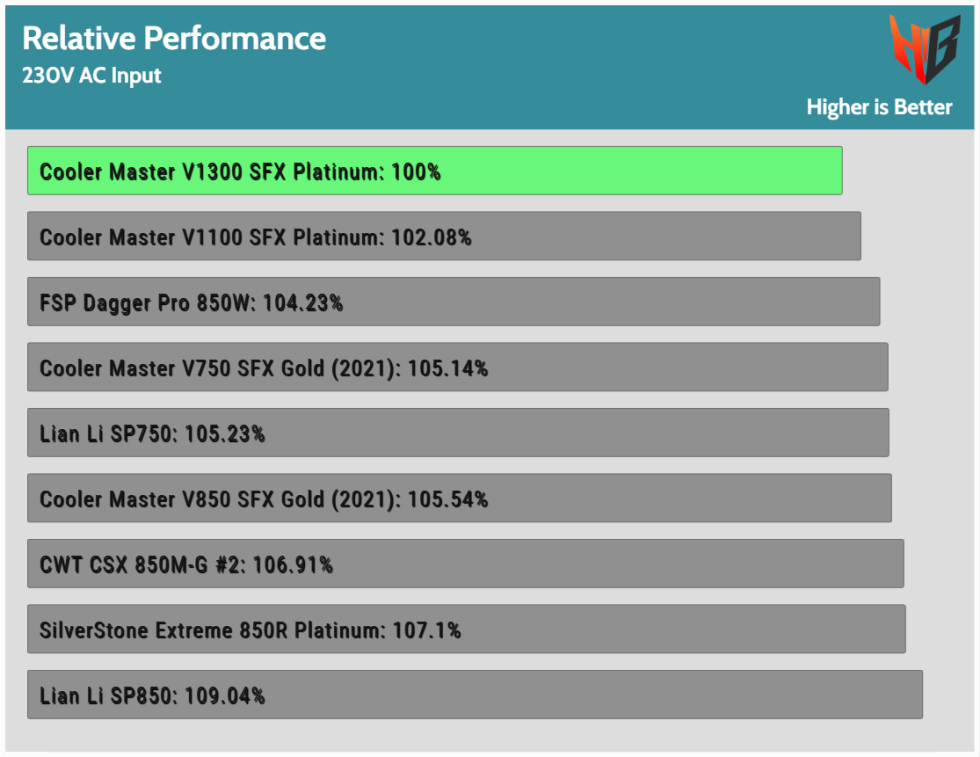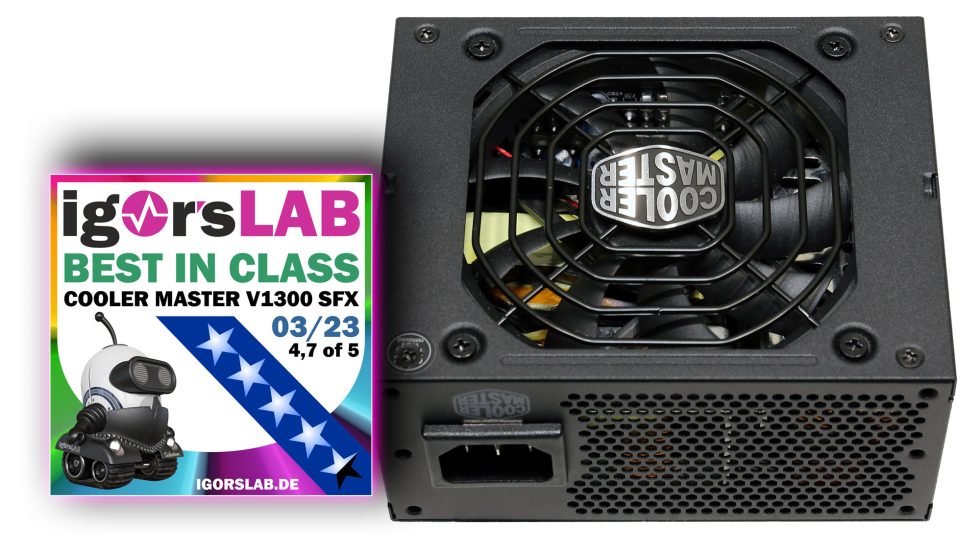Summary and conclusion
The overall performance might seem a bit too low compared to other SFX devices at first glance. But the extremely high power density alone is the limiting factor here, so the comparison with other SFX models with lower performance is actually even unfair. Also, the performance leader, the Lian Li SP850, has a serious design flaw that I don’t know if it’s fixed in the current generation. You can read more about it in my review of this PSU.
The Cooler Master V1300 SFX is basically a modified V1100 SFX power supply, but it only supports 200-240V input. Thanks to its SFX form factor and huge 1300W output, it is the current leader in power density among all desktop power supplies on the market today. If you need a mini PSU to power your RTX 4090 and a heavily overclocked CPU, the V1300 SFX won’t let you down as it comes with a native 12VHPWR connector and also meets the stringent ATX v3.0 transient response tests for devices with this connector. In other words, it can deliver up to 2600W for ultra-short periods (0.1ms).
Build quality is high and the package is rich, including an SFX-to-ATX adapter bracket that lets you fit the PSU into a regular ATX case as long as the short cables don’t cause compatibility issues. If you ask me, this adapter is not that useful for most SFX devices because of the short cables. It would be better if it was sold as a kit together with longer cables. Just as a suggestion. Of course, you would then get better (larger) power supplies for less money.
Another plus point of the V1300 SFX is the not too loud operation. I expected a very high average noise level, but when I received the test results, I found that it barely exceeds 30 dBA, making this one of the quietest SFX models on the market. Thus, you have a high performance and still a sufficiently quiet operation at the same time. That still leaves the price. Cooler Master’s MSRP are 310 USB and 330 USD (excluding taxes and duties) for the V1100 and the V1300, respectively. These are pretty steep prices, which then already just exceed the 400 euro mark (inl. VAT) in Germany exceed. Whether one does this to oneself is, of course, strongly case-dependent.
But if you need the highest possible power density, you will unfortunately have to pay for it. If you don’t need as much power, but still want ATX v3.0 compatibility, check out the SilverStone Extreme 850R Platinum, which offers good performance and quiet operation. There’s also the excellent Corsair SF750, though it hasn’t yet been updated to meet ATX v3.0 requirements.
| Per | Contra |
| Full power at 47°C Super high power density SFX12V 4.0 (equivalent to ATX v3.0) and PCIe 5.0 ready 600W 12VHPWR connector One of the few PSUs with fan failure protection High efficiency with 230V input Low average noise (31.16 dBA) Premium build quality Correctly set OPP and OCP (except 3.3V at high temperatures) Tight load regulation at 12V and 5VSB Low inrush current at 230V ALPM support FDB fan Fully modular Comes with SFX-to-ATX bracket adapter 10-year warranty |
APFC converter must be tuned Increased ripple at 12V under full load Short bridging time Insufficient load regulation on the shunts Transient response at 5 V |
Many thanks to Aris, whose data I am allowed to use in the future and will do so, if readers want such network tests. Today’s article is once again a gauge of whether this topic resonates with you, especially for such fancy or rarePower Supplies. And I also specifically chose this power supply this time because I had it myself in practical use with an NVIDIA RTX 4090 FE cranked up to 600 watts. Works easily. And I will soon install the power supply in a SFX project and let it sweat nicely with the matching graphics card. This is a teaser…
The original appeared on hwbusters.com
- 1 - Einführung, technische Daten und Testreport
- 2 - Unboxing, Kabel und Schutzschaltungen
- 3 - Teardown: Topologie, Komponenten, Verarbeitung
- 4 - Load Regulation, Ripple Suppression, Transient Resonse
- 5 - Hold-Up Time, Timings, Inrush-Current
- 6 - Average Efficiency and PF
- 7 - Betriebsgeräusch und Lüfter
- 8 - Zusammenfassung und Fazit



































10 Antworten
Kommentar
Lade neue Kommentare
Veteran
1
Neuling
Urgestein
Veteran
Urgestein
Urgestein
1
Veteran
Veteran
Alle Kommentare lesen unter igor´sLAB Community →